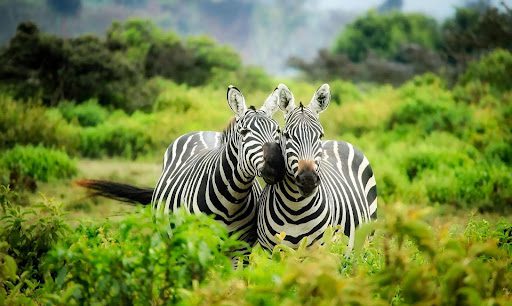Stripes in the Wild: Exploring the Enchanting World of Zebras
In the heart of Africa, where the sun paints the land in gold and the mountains stand tall, lives a creature that’s both striking and mysterious – the zebra.
Imagine a world where animals wear black and white stripes like a fashionable outfit. Today, we’re taking a closer look at these amazing creatures and the adventures they face. Let’s explore the wild, where zebras are like nature’s living art, and their stories are told in every stripe.
It’s a wild journey you won’t want to miss! Welcome to the zebra’s world – where every stripe has a tale to share.
First, let’s get acquainted with the Plains zebra (Equus quagga). This species is renowned for its striking black and white stripes and is the most common and geographically widespread species of zebra.
They are a vital part of the ecosystem, grazing on grass and helping to maintain environmental equilibrium.
Plains zebras are highly social creatures, living in small family groups consisting of a male (stallion), several females, and their young. These units may combine with others to form herds that can number in the thousands.
However, the intrusion of human activities into their habitats poses a significant threat. As human settlements expand, the living spaces available to these zebras shrink, decreasing their population in certain areas.
Researchers approximate the wild population to be in the range of 660,000 to 1,000,000 individuals. While the Plains zebra is not currently classified as endangered, the reduction in the size of some groups highlights their susceptibility to changes in their habitat.
It’s also worth noting that the Plains zebra has six or seven recognized subspecies, including the extinct quagga. The quagga, a subspecies of the Plains zebra, was once found in vast herds on the great plains of South Africa but is now extinct.
Now, let’s head to the rugged terrains of southern Africa, home to the resilient Mountain Zebra (Equus zebra). This zebra, recognized for its unique stripes, is categorized into two subspecies: the Cape Mountain Zebra (E. z. zebra) and the Hartmann’s Mountain Zebra (E. z. hartmannae).
Like all other zebras, they proudly wear bold black or dark brown stripes, ensuring that no two zebras look exactly the same. Their entire body is adorned with these distinctive stripes, leaving only the belly without any. The main color for the Cape Mountain zebra is essentially white, while in Hartmann’s zebra, the ground color has a subtle buff tint.
Currently, the Mountain Zebra population is stable, with an estimated population of 34,979 mature individuals but vigilance is necessary. The encroachment of human activities into their habitats poses a significant threat. Conservation efforts are underway to protect their habitats and ensure they have sufficient food resources.
Lastly, let’s turn our attention to the northern regions of Africa, where the Grévy’s zebra (Equus grevyi), also known as the imperial zebra, resides. This is the largest living wild equid and the most threatened of the three zebra species, with a population of approximately 2,800 individuals
Grévy’s zebras are easily recognizable by their thin, closely spaced stripes and large, round ears that can move independently in different directions.
Similar to other zebra species, the coat of the Grévy’s zebra showcases a pattern of black and white stripes. These stripes are narrow and closely arranged, widening on the neck and reaching all the way down to the hooves.
What makes the Grévy’s zebra distinctive is that its belly and the region around the tail base are devoid of stripes, appearing entirely white. This feature sets Grévy’s zebra apart. When born, foals exhibit brown and white striping, with the brown stripes darkening as they mature.
These zebras are native to Ethiopia and northern Kenya and well-adapted to life in dry, semi-arid scrub and grasslands. They graze on grasses, forbs, and even bark, fruit, and leaves.
Unlike other zebra species, Grévy’s zebras are more solitary in nature, often preferring to spend time alone, but interestingly, they can often be found in large collections of other grazers, such as wildebeest, ostriches, and antelopes, which they help out by nipping off the dry, hardened grass tips that are too tough for other herbivores to digest.
Unfortunately, the Grévy’s zebra is currently classified as endangered. This means their numbers are dwindling, with the wild population estimated at only around 2,250 animals as of 2020.
Their habitats are undergoing significant changes due to human activities, and they are sometimes hunted for their distinctive striped coats.
As the sun sets in Africa, the stories of zebras unfold – tales of survival in the wide fields and towering mountains. But we can’t ignore the unseen challenges zebras face when the night falls.
What struggles, hidden in their stripes, need our attention? The wild is like a big puzzle, and it’s up to us to protect it. Zebras depend on us to keep their homes safe. We can all be part of this by caring for the environment and making choices that help wildlife.
It promises to ensure zebras and other animals have a place to live and thrive. Let’s work together to keep their stories alive and protect the beauty of the wild for everyone to enjoy.


